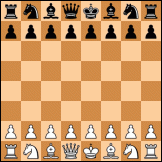Hello:
Peter Berger wrote: ↑Sat Oct 11, 2025 11:08 am
I am still not quite sure, that I have understood completely what you can already do and what you can't. I think I understand how this works with a PGN that has evals for both sides though.
Let's make the challenge one natural level more difficult. The following game is most clearly an excellent example of superior strategical insight. We can see the evals of Lc0 v0.32.0 in the PGN, we can't see the Crafty ones. But I can tell you about them - Crafty thought that it was better for several consecutive moves, and it even offered a draw as late as move 28 (because of several consecutive moves with 0.00 eval) - it resigned only a very few moves later.
We can rule out purely tactical reasons here as my notebook doesn't have a GPU - also I could see lc0s mainlines live - there were no tactical reasons for its initial assessment.
What would be your current idea to show that we see an example of superior strategic insight here?
Peter
[...]
Just enclosing the game between PGN tags to know what is going on:
[pgn][Event "Lang 120min+10sek"]
[Site "Berlin"]
[Date "2025.10.11"]
[Round "?"]
[White "Lc0 v0.32.0"]
[Black "Crafty 25.6"]
[Result "1-0"]
[ECO "E04"]
[PlyCount "71"]
[TimeControl "7200+10"]
{4096MB, DESKTOP-8OCGGEO} 1. d4 {[%eval 9,6] [%wdl 201,642,157] [%emt 0:07:20]} Nf6 {[%emt 0:00:07]} 2. c4 {[%eval 14,6] [%wdl 214,636,150] [%emt 0:01:48]} e6 {[%emt 0:00:06] (c6)} 3. g3 {[%eval 19,7] [%wdl 222,643,135] [%emt 0:07:01]} d5 {[%emt 0:00:07] (Lb4+)} 4. Bg2 {[%eval 19,8] [%wdl 213,661,126] [%emt 0:04:40]} dxc4 {[%emt 0:00:07] (Lb4+)} 5. Nf3 {[%eval 22,10] [%wdl 218,667,115] [%emt 0:01:36]} Nc6 {[%emt 0:00:06] (c5)} 6. Qa4 {[%eval 43,12] [%wdl 298,600,102] [%emt 0:01:44]} Bb4+ {[%emt 0:00:07]} 7. Bd2 {[%eval 35,16] [%wdl 285,589,126] [%emt 0:01:27]} Bd6 {[%emt 0:00:06] (Sd5)} 8. Na3 {[%eval 40,9] [%wdl 291,601,108] [%emt 0:04:05]} Bxa3 {[%emt 0:00:07] (Se4)} 9. Qxa3 {[%eval 49,8] [%wdl 327,566,107] [%emt 0:01:26]} Ne4 {[%emt 0:00:07] (Dd6)} 10. Bf4 {[%eval 41,8] [%wdl 300,586,114] [%emt 0:02:56]} f6 {[%emt 0:04:46] (Sd6)} 11. O-O {[%eval 63,8] [%wdl 374,535,91] [%emt 0:02:36]} Qe7 {[%emt 0:06:07] (Sd6)} 12. Qa4 {[%eval 56,10] [%wdl 355,542,103] [%emt 0:00:13]} c3 {[%emt 0:02:48]} 13. Qc2 {[%eval 50,11] [%wdl 327,573,100] [%emt 0:04:20]} cxb2 {[%emt 0:02:42]} 14. Qxb2 {[%eval 53,12] [%wdl 330,580,90] [%emt 0:03:03]} Nd6 {[%emt 0:00:31] (0-0)} 15. e4 {[%eval 57,9] [%wdl 346,569,85] [%emt 0:02:00]} O-O {[%emt 0:03:18]} 16. e5 {[%eval 45,11] [%wdl 318,567,115] [%emt 0:01:46]} Nc4 {[%emt 0:01:54] (fxe5)} 17. exf6 {[%eval 84,8] [%wdl 446,483,71] [%emt 0:01:42]} gxf6 {[%emt 0:00:39]} 18. Qc1 {[%eval 73,8] [%wdl 415,490,95] [%emt 0:03:44]} Nb6 {[%emt 0:02:28]} 19. Re1 {[%eval 69,9] [%wdl 406,485,109] [%emt 0:00:41]} Rd8 {[%emt 0:05:38] (Sd5)} 20. g4 {[%eval 82,11] [%wdl 451,434,115] [%emt 0:02:54]} Nd5 {[%emt 0:06:36] (Sxd4)} 21. Bg3 {[%eval 119,8] [%wdl 560,380,60] [%emt 0:01:36]} a5 {[%emt 0:02:14]} 22. g5 {[%eval 115,9] [%wdl 543,380,77] [%emt 0:01:36]} fxg5 {[%emt 0:02:21] (f5)} 23. Nxg5 {[%eval 115,10] [%wdl 544,377,79] [%emt 0:02:08]} Nxd4 {[%emt 0:03:07]} 24. Be5 {[%eval 112,14] [%wdl 533,381,86] [%emt 0:00:45]} h6 {[%emt 0:04:20] (Sf5)} 25. Ne4 {[%eval 117,10] [%wdl 552,381,67] [%emt 0:02:32]} Nc6 {[%emt 0:04:51]} 26. Bg3 {[%eval 118,11] [%wdl 557,383,60] [%emt 0:01:02]} Qg7 {[%emt 0:04:15] (Df8)} 27. Kh1 {[%eval 184,9] [%wdl 724,239,37] [%emt 0:03:10]} Kh8 {[%emt 0:01:25]} 28. Rg1 {[%eval 193,10] [%wdl 740,224,36] [%emt 0:01:42]} Rg8 {[%emt 0:01:24] R} 29. Qd2 {[%eval 201,10] [%wdl 761,208,31] [%emt 0:01:37]} h5 {[%emt 0:08:39] (Df8)} 30. Rae1 {[%eval 684,6] [%wdl 967,26,7] [%emt 0:05:16]} Rb8 {[%emt 0:02:39] (Ld7)} 31. h3 {[%eval 1008,6] [%wdl 978,18,4] [%emt 0:04:39]} b6 {[%emt 0:02:23] (Ld7)} 32. Rc1 {[%eval 681,6] [%wdl 966,28,6] [%emt 0:02:08]} h4 {[%emt 0:01:22]} 33. Bh2 {[%eval 822,7] [%wdl 973,22,5] [%emt 0:01:02]} Nde7 {[%emt 0:01:16] (Lb7)} 34. Bf3 {[%eval 1160,7] [%wdl 983,11,6] [%emt 0:02:18]} Bb7 {[%emt 0:04:04] (Df8)} 35. Rxg7 {[%eval 4393,6] [%wdl 996,3,1] [%emt 0:01:53]} Rxg7 {[%emt 0:00:35]} 36. Qh6+ {[%eval 3312,6] [%wdl 994,6,0] [%emt 0:03:42]} 1-0[/pgn]
Black king safety is horrible. I expected
34.- ..., Qf8 after
34.- Bf3, keeping an eye on h6 square for the mating threat Qh6# in
Epaulette-like style (not
34.- ..., Qf7; 35.- Qh6+, Qh7; 36.- Qxh7+, Kxh7; 37.- Nf6+, forking the king and rook) and having a hard time defending, surely losing. Therefore,
34.- ..., Bb7 surprised my fairly low level experience, thinking it was directly throwing in the towel and making things easier for white, gifting a queen for a rook; only to learn later that SF thinks that this position is clearly lost for black regardless of what plays (
34.- ..., Bb7;
34.- ..., Ng6;
34.- ..., Qf8; etc.), with evals over +7.
I was not aware of the long TC of the game.
Regards from Spain.
Ajedrecista.
